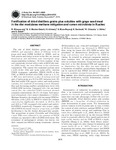
Please use this identifier to cite or link to this item:
http://ricaxcan.uaz.edu.mx/jspui/handle/20.500.11845/885| Title: | Fortification of dried distillers grains plus solubles with grape seed meal in the diet modulates methane mitigation and rumen microbiota in Rusitec |
| Authors: | Khiaosa-Ard, R Metzler-Zebeli, BU Ahmed, Sadek Muro Reyes, Alberto Deckardt, K Chizzola, R Böhm, J Zebeli, Quendrim |
| Issue Date: | 2015 |
| Publisher: | Federation of Animal Science Societies Elsevier |
| Abstract: | The role of dried distillers grains plus solubles (DDGS) and associative effects of different levels of grape seed meal (GSM) fortified in DDGS, used as both protein and energy sources in the diet, on ruminal fermentation and microbiota were investigated using rumen-simulation technique. All diets consisted of hay and concentrate mixture with a ratio of 48:52 [dry matter (DM) basis], but were different in the concentrate composition. The control diet contained soybean meal (13.5% of diet DM) and barley grain (37%), whereas DDGS treatments, unfortified DDGS (19.5% of diet DM), or DDGS fortified with GSM, either at 1, 5, 10, or 20% were used entirely in place of soybean meal and part of barley grain at a 19.5 to 25% inclusion level. All diets had similar DM, organic matter, and crude protein contents, but consisted of increasing neutral detergent fiber and decreasing nonfiber carbohydrates levels with DDGS-GSM inclusion. Compared with the soy-based control diet, the unfortified DDGS treatment elevated ammonia concentration (19.1%) of rumen fluid associated with greater crude protein degradation (~19.5%). Methane formation decreased with increasing GSM fortification levels (≥5%) in DDGS by which the methane concentration significantly decreased by 18.9 to 23.4 and 12.8 to 17.6% compared with control and unfortified DDGS, respectively. Compared with control, unfortified DDGS decreased butyrate proportion, and GSM fortification in the diet further decreased this variable. The proportions of genus Prevotella and Clostridium cluster XIVa were enhanced by the presence of DDGS without any associative effect of GSM fortification. The abundance of methanogenic archaea was similar, but their composition differed among treatments; whereas Methanosphaera spp. remained unchanged, proportion of Methanobrevibacter spp. decreased in DDGS-based diets, being the lowest with 20% GSM inclusion. The abundance of Ruminococcus flavefaciens, anaerobic fungi, and protozoa were decreased by the GSM inclusion. As revealed by principal component analysis, these variables were the microorganisms associated with the methane formation. Grape seed meal fortification level in the diet decreased DM and organic matter degradation, but this effect was more related to a depression of nonfiber carbohydrates degradation. It can be concluded that DDGS fortified with GSM can favorably modulate ruminal fermentation. |
| Description: | The role of dried distillers grains plus solubles (DDGS) and associative effects of different levels of grape seed meal (GSM) fortified in DDGS, used as both protein and energy sources in the diet, on ruminal fermentation and microbiota were investigated using rumen-simulation technique. All diets consisted of hay and concentrate mixture with a ratio of 48:52 [dry matter (DM) basis], but were different in the concentrate composition. The control diet contained soybean meal (13.5% of diet DM) and barley grain (37%), whereas DDGS treatments, unfortified DDGS (19.5% of diet DM), or DDGS fortified with GSM, either at 1, 5, 10, or 20% were used entirely in place of soybean meal and part of barley grain at a 19.5 to 25% inclusion level. All diets had similar DM, organic matter, and crude protein contents, but consisted of increasing neutral detergent fiber and decreasing nonfiber carbohydrates levels with DDGS-GSM inclusion. Compared with the soy-based control diet, the unfortified DDGS treatment elevated ammonia concentration (19.1%) of rumen fluid associated with greater crude protein degradation (~19.5%). Methane formation decreased with increasing GSM fortification levels (≥5%) in DDGS by which the methane concentration significantly decreased by 18.9 to 23.4 and 12.8 to 17.6% compared with control and unfortified DDGS, respectively. Compared with control, unfortified DDGS decreased butyrate proportion, and GSM fortification in the diet further decreased this variable. The proportions of genus Prevotella and Clostridium cluster XIVa were enhanced by the presence of DDGS without any associative effect of GSM fortification. The abundance of methanogenic archaea was similar, but their composition differed among treatments; whereas Methanosphaera spp. remained unchanged, proportion of Methanobrevibacter spp. decreased in DDGS-based diets, being the lowest with 20% GSM inclusion. The abundance of Ruminococcus flavefaciens, anaerobic fungi, and protozoa were decreased by the GSM inclusion. As revealed by principal component analysis, these variables were the microorganisms associated with the methane formation. Grape seed meal fortification level in the diet decreased DM and organic matter degradation, but this effect was more related to a depression of nonfiber carbohydrates degradation. It can be concluded that DDGS fortified with GSM can favorably modulate ruminal fermentation. |
| URI: | http://localhost/xmlui/handle/20.500.11845/885 https://doi.org/10.48779/jjnj-1v57 |
| ISSN: | 0022-0302 |
| Other Identifiers: | info:eu-repo/semantics/publishedVersion |
| Appears in Collections: | *Documentos Académicos*-- UA Veterinaría |
Files in This Item:
| File | Description | Size | Format | |
|---|---|---|---|---|
| Khiaosa et al 2015.pdf | 1,83 MB | Adobe PDF |  View/Open |
This item is licensed under a Creative Commons License
